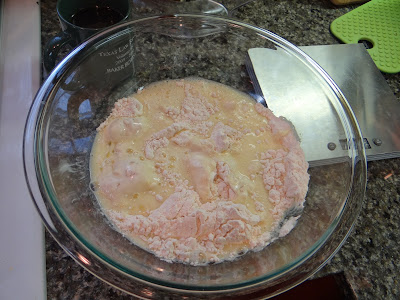Saturday, November 30, 2013
Bread for communion by intinction part II, now with more bread math!
Here is the post where I tell you how I came up with the recipe for my "look pretty" loaf for my church's communion by intinction tomorrow!
If you have no idea what I'm talking about, click here.
In the last post, I gave you the recipe for the challah, which I cut up and used to fill the bread bowl. The challah is the part that people will actually eat. It's the "be tasty" loaf.
The "look pretty" loaf is the one that sits on the table in the front of the sanctuary, and which the pastor holds up and tears in half while telling the story of the Last Supper. Its entire job is to look nice and be tear-able.
How do you make a loaf that tears easily? Well, you need to add some sort of fat to enrich it. I'm no food scientist, but I know that fat tenderizes the dough, making it easier to tear. Fats can include milk, butter, oil, or eggs.
However, you can't just throw these into a dough and call it a day. They contribute to the overall hydration of the dough in indirect ways that need to be compensated for.
This is a job for.... bread math!
I decided I was going to add milk and an egg to soften my usual simplified 1-2-3 dough. Here is how I did it:
My 1-2-3 loaf uses 375g of flour and 250g of water. So the milk and egg would need to be a part of the 250g of water.
First, I figured out that milk is considered 82% hydration and an egg is 75% hydration. That means they are 82% and 75% water respectively, and the rest is fat (or protein).
So in order to keep my 60% hydration level, I would have to measure the milk and egg by weight and calculate 82% of the milk and 75% of the egg and add them together along with some more water to equal 250g.
Here is my equation (if you can't see in the above photo):
(milk * .82) + (egg * .75) + (water) = 250g
The egg was 57g, so 75% of the egg's weight would be 42.75g.
I measured out some milk and it was 125g, so 82% was about 100g.
Now the equation looked like this:
(100) + (43) + (water) = 250g
So I needed 106g of water to reach 250g!
Along with the 375g of flour and 250g of water (and egg and milk) you should add about 7g of salt and 7g of yeast. Salt and yeast don't change the hydration; only flour and water do.
All mixed up, it looked like this:
I covered it with plastic wrap and gave it a few stretch and folds once an hour or so, making sure the gluten was developing correctly. It took about five hours to fully rise. Here it is looking all smooth once the dough had time to rest and then the gluten strands started to form.
After the first rise, transfer to a piece of parchment paper and let rise another hour while you preheat the oven to 375 degrees F. I've found that enriched breads do better at lower temperatures than in the screaming hot temperatures that lean doughs seem to love. Oh, and throw your dutch oven into the oven as well.
The dough was really sticky still so I covered it with flour.
When the dough is ready, score the top with a sharp knife and put it in the dutch oven with the lid on. Bake for 25 minutes, then remove the lid and bake another 15 minutes until the bread is golden and sounds hollow when tapped.
Yay! Pretty bread is pretty!
When your bread has cooled down, wrap it in plastic wrap and place it in your bag along with the bread bowl and your cut up challah pieces to bring over to the church.
Stay tuned for the third and final segment in this series on making bread for communion by intinction: making the bread bowl!
Subscribe to:
Post Comments (Atom)









No comments:
Post a Comment